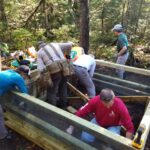Privy Choices: Facts of the Matter

Mar 4, 2022


Mar 4, 2022

Human waste is a natural part of life. Managing human waste properly while in the backcountry is vital for the protection of the environment and for providing an enjoyable visitor experience. Visitors to public lands, like the Appalachian Trail (A.T.), typically do not need to think much about which bathroom facility to use because the closest privy (or a proper cathole) is usually enough. However, land managers and volunteers with Trail maintaining clubs have a lot more to consider when thinking about how to manage waste in the backcountry.
The Pit
Imagine the iconic stench of an outhouse (also known as a privy) and consider for a moment that the toilet you sit upon is placed above a hole in the ground. This style of privy is often referred to as a pit privy, which is generally a low cost and low maintenance design. Often cramped and odorific, this type of privy is probably memorable to A.T. hikers of the past.
Each time the hole beneath the structure is filled to the brim, the entire outhouse structure must be moved and placed above an entirely new and freshly dug hole. Meanwhile, the old hole, now full of human waste, can take decades to properly decompose. This style of managing human waste increases the potential risk to water quality within the surrounding environment, which is why moldering privies are the approach A.T. managers prefer.
Moldering Privies (with multiple cribs)
Moldering privies are typically better-ventilated structures that have multiple above-ground chambers (known as cribs) constructed below the structure floor to collect human waste. This type of cool composting design allows for waste to be worked on by oxygen-loving (aerobic) bacteria that help decomposition. When hikers add wood shavings or leaf litter to the pile after use, it helps provide air gaps so the oxygen-loving bacteria can better function. For some hikers, tossing in wood shavings after their business can easily evoke the memory of flushing a toilet.
Instead of needing to move the whole super-structure as with a pit privy, once a crib is full, the toilet riser is moved to the next empty crib while decomposition does its work on the last pile. Generally, filled cribs can be emptied after two years of composting, which is a much faster decomposition time when compared to the decades needed for a pit privy.
Moldering privy designs require more construction material and manual maintenance needs when compared to a pit privy. However, the moldering privy offers minimal risk of water and soil contamination and they typically release less of an odor. The compost that they produce as an end product is also pathogen-free.
Trail Clubs in New England and Virginia are working on replacing pit privies with moldering privies to improve the environment, which will likely improve hiker experiences, too. If you are interested in volunteering to help care for these important overnight site resources, contact volunteer@appalachiantrail.org and mention this specific interest so we can connect you with the Trail Club near you.
Trail managers can learn more about backcountry sanitation and overnight areas by reviewing the following resources: